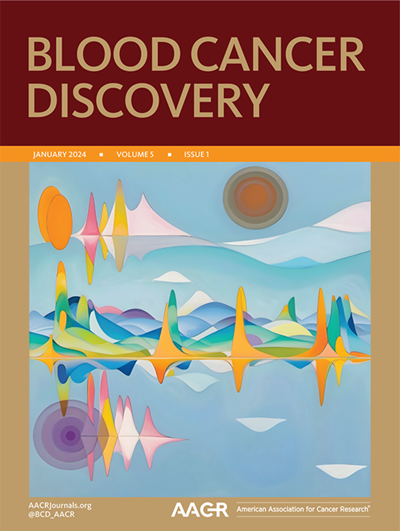摘要:布苏凡细胞毒性调节后骨髓微环境的年龄和剂量相关变化
IF 11.5
Q1 HEMATOLOGY
引用次数: 0
摘要
造血细胞移植(HCT)是一种常用的血液恶性肿瘤治疗方法,如急性髓性白血病、多发性骨髓瘤、淋巴瘤和非恶性疾病。HCT前的准备方案会损伤骨髓(BM)生态位,但目前尚不完全清楚细胞毒性预处理(无论是高强度还是低强度)如何随着时间的推移影响骨和BM的重塑、再生和随后的造血恢复。此外,受体年龄对这些因素的影响还没有完全描述。在这项研究中,我们试图纵向研究低强度和高强度Busulfan (BU)调节后的骨和BM重塑,目的是了解BM生态位改变在移植后造血系统恢复中的作用。利用双光子活体显微镜,我们观察了移植后第2天、第5天和第42天幼龄和成年小鼠的骨和骨髓变化。低强度和高强度调节分别注射40 mg/kg和80 mg/kg丁硫凡。Busulfan是一种DNA烷基化药物,与环磷酰胺联合用于临床治疗白血病。然后用C57BL/6-Tg(UBC-GFP)小鼠的1 × 106个全BM细胞移植小鼠。在实时成像中,研究了血管系统的功能和造血恢复。对于离体成像,血管标记荧光抗体(Alexafluor 647偶联抗cd31、CD144和Sca-1)和钙结合染料(dye1;钙黄绿素,Dye2;在心内灌注前给予茜素。然后收获长骨,冷冻,削去皮质层,使BM可视化。血管分析显示,即使在42天后,低强度和高强度调理中渗漏都增加,表明调理后内皮恢复延迟。血管网络的形态学评估显示,在早期时间点,血管的频率减少,血管的大小和密度增加,仅在年轻小鼠中,在第42天部分恢复。幼龄小鼠的骨重塑在第5天显示出染料1/染料2比率的降低,到第42天下降更为显著。在成年小鼠中,仅在治疗后第42天,在bu条件小鼠中观察到低比例。为了进一步研究,我们根据两种染料的比例将干骺端长骨腔分为沉积型、混合型和吸收型。分类分析表明,随着时间的推移,bu条件小鼠中染料1/染料2比值的降低主要是由于与对照组相比,bu条件小鼠中吸收型骨腔的增加。尽管已知供体HSC移植与年龄和剂量有关,但我们的研究结果表明,骨和骨髓的长期微环境变化可能进一步影响造血功能的恢复。总之,我们的结果展示了骨重塑和骨髓再生可能影响造血恢复的新方面,值得进一步研究。引用格式:Joel A Spencer, Christian Burns, Ruth Verrinder, Farhad Ghazali, Nastaran Abbasizadeh。布苏凡细胞毒性调节后骨髓微环境的年龄和剂量相关变化[摘要]。摘自:AACR特别会议论文集:急性髓性白血病和骨髓增生异常综合征;2023年1月23-25日;费城(PA): AACR;血癌发现[j]; 2009;4(3 -增刊):摘要/ Abstract本文章由计算机程序翻译,如有差异,请以英文原文为准。
Abstract A26: Age and Dose Related Changes to the Bone Marrow Microenvironment after Cytotoxic Conditioning with Busulfan
Hematopoietic Cell Transplantation (HCT) is a frequently used treatment for hematologic malignancies such as acute myeloid leukemia, multiple myeloma, lymphoma and non-malignant diseases. Preparative regimens before HCT damage the Bone Marrow (BM) niche, but it is not fully known how the cytotoxic preconditioning, whether High or Low intensity, impacts bone and BM remodeling, regeneration, and subsequent hematopoietic recovery over time. In addition, the effect of recipient age on these factors has not been completely described. In this study, we sought to longitudinally investigate bone and BM remodeling after Low and High intensity Busulfan (BU) conditioning with the aim of understanding the role that BM niche alterations play in the recovery of the hematopoietic system after transplantation. Using two-photon intravital microscopy, we visualized bone and BM changes in young and adult mice on days 2, 5, and 42 post-transplantation. Both Low and High intensity conditioning were administered with injections of 40 mg/kg and 80 mg/kg busulfan, respectively. Busulfan is a DNA alkylating drug that in combination with cyclophosphamide is being clinically used to treat leukemia. Mice were then transplanted with 1 × 106 whole BM cells from a C57BL/6-Tg(UBC-GFP) mouse. During live imaging, functionality of the vascular system and hematopoietic recovery were studied. For ex vivo imaging, vascular labeling fluorescent antibodies (Alexafluor 647 conjugated to anti-CD31, CD144, and Sca-1) and calcium binding dyes (dye1; Calcein, Dye2; Alizarin) were administered before intracardiac perfusion. Then long bones were harvested, frozen, and the cortical layer was shaved to enable visualization of the BM. Vascular analysis indicated increased leakage in both Low and High intensity conditioning even after 42 days suggesting delayed endothelial recovery following conditioning. Morphological evaluation of the vascular network revealed a decrease in the frequency and increase in the size and density of the vessels at early timepoints that was partially restored by day 42 in young mice only. Bone remodeling in young mice showed a reduction in the dye1/dye2 ratio at day 5 and a more significant decrease by day 42. In the adult mice, a low ratio was observed in BU-conditioned mice only at day 42 post treatment. To further investigate, we classified the metaphyseal and epiphyseal long bone cavities as deposition type, mixed type, and resorption type based on the ratio of the two dyes. The classification analysis indicates that the reduction in dye1/dye2 ratio in BU-conditioned mice over time is primarily due to an increase in resorption type bone cavities in BU-conditioned mice compared to the control. Although donor HSC engraftment is known to be age and dose dependent, our results indicate that long-term microenvironmental changes in the bone and bone marrow may further impact hematopoietic recovery. Overall, our results demonstrate new aspects of bone remodeling and bone marrow regeneration that may influence hematopoietic recovery and warrant further investigation.
Citation Format: Joel A Spencer, Christian Burns, Ruth Verrinder, Farhad Ghazali, Nastaran Abbasizadeh. Age and Dose Related Changes to the Bone Marrow Microenvironment after Cytotoxic Conditioning with Busulfan [abstract]. In: Proceedings of the AACR Special Conference: Acute Myeloid Leukemia and Myelodysplastic Syndrome; 2023 Jan 23-25; Austin, TX. Philadelphia (PA): AACR; Blood Cancer Discov 2023;4(3_Suppl):Abstract nr A26.
求助全文
通过发布文献求助,成功后即可免费获取论文全文。
去求助
来源期刊

Blood Cancer Discovery
Multiple-
CiteScore
12.70
自引率
1.80%
发文量
139
期刊介绍:
The journal Blood Cancer Discovery publishes high-quality Research Articles and Briefs that focus on major advances in basic, translational, and clinical research of leukemia, lymphoma, myeloma, and associated diseases. The topics covered include molecular and cellular features of pathogenesis, therapy response and relapse, transcriptional circuits, stem cells, differentiation, microenvironment, metabolism, immunity, mutagenesis, and clonal evolution. These subjects are investigated in both animal disease models and high-dimensional clinical data landscapes.
The journal also welcomes submissions on new pharmacological, biological, and living cell therapies, as well as new diagnostic tools. They are interested in prognostic, diagnostic, and pharmacodynamic biomarkers, and computational and machine learning approaches to personalized medicine. The scope of submissions ranges from preclinical proof of concept to clinical trials and real-world evidence.
Blood Cancer Discovery serves as a forum for diverse ideas that shape future research directions in hematooncology. In addition to Research Articles and Briefs, the journal also publishes Reviews, Perspectives, and Commentaries on topics of broad interest in the field.
 求助内容:
求助内容: 应助结果提醒方式:
应助结果提醒方式:


